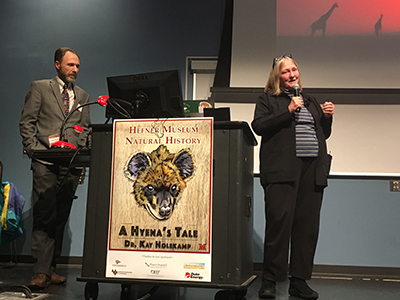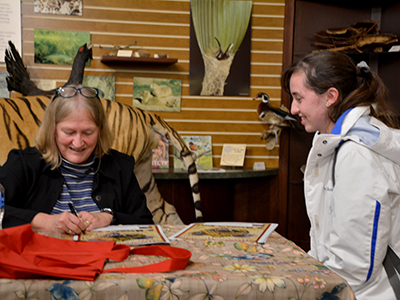Zoologist Kay Holekamp gives enlightening insight into hyenas for the 45th annual Hefner Lecture

Written by Caroline Igo, CAS communications intern

Steve Sullivan introduces Kay Holekamp.
Kay Holekamp, director of Michigan State University's interdisciplinary program in Ecology, Evolutionary Biology & Behavior, was invited to Miami to discuss her work with hyenas in honor of the Hefner Museum of Natural History's 45th annual lecture. The presentation, "A Hyena's Tale," was held in Benton Hall on November 7.
Holekamp, who has worked with hyenas in east Africa for more than three decades, began by stating, "These animals have a big PR problem. They have had a very bad reputation for centuries." She pointed to examples in literature, folklore, and Disney. "Not only do we have the 1994 Lion King, but also the newly released Lion King. Hyenas are so easily demonized," she said.
She explained that she had originally intended to spend only 3-4 years researching hyenas before moving on to parrots or dolphins. "But the animals are so bizarre and interesting that I am still there," she said. "My job today is to tell you why I find hyenas so fascinating and why I study them."
Extraordinary Immune Systems and Adaptability
"First of all, these animals have a rather extraordinary immune system. They can, for example, eat anthrax and not die," Holekamp said, adding that just one bite of this poison is enough to kill a human.
In the early 1990s, she said, there was an epidemic that swept through parts of Africa and wiped out about a third of the lions but none of the hyenas. Holekamp and her team took blood samples from the hyenas in that region and found that about 40% of them had seen the disease, but none of them showed any symptoms.
"Hyenas can even take an attack from a large cobra, get sick for a few days, and then come back like nothing ever happened," she said. "It is quite extraordinary what they can tolerate in terms of toxins and pathogens."
"Even more interesting, hyenas seems to violate a lot of basic rules of mammalian biology," she said, comparing them to elk and lions. "Charles Darwin was one of the first to notice that male mammals appear and act differently than female mammals."
However, hyenas do not apply to this rule. Holekamp showed the audience pictures of a male and female lion and a male and female hyena. Compared to the two lions, it was very difficult to identify the female hyena.
"This is because females are typically larger, more socially dominant, and more aggressive than the males," she said.
Important Roles in the African Ecosystem

Kay Holekamp signs a poster for a student.
"Hyenas are very effective feeders [and predators] and can eat a whole antelope in a matter of 15 minutes," said Holekamp, "and it is because of their extreme morphological adaptations."
She noted that almost 15,000 newtons of force are required to break open a giraffe femur, but adult hyenas have the ability to do this because of their main jaw-closing muscles on their large skulls.
"All types of bone-cracking hyenas have identical skull structures," Holecamp said. "And the first bone-cracking skull is said to have belonged to a creature 13 million years ago."
She explained that this feeding ability has given hyenas an important role in the ecosystem. The animals are found just about everywhere throughout the African continent and are very adaptable. Hyenas can exist on just about any available food source.
Holekamp and her research team set out to observe the spotted hyena population in relationship with other mammal populations they live with. "We wanted to know if they can be used as ecosystem sentinels in respect to other large carnivores," she said.
The team was able to plot data after months of observations, finding that changes in hyena numbers could predict changes in other species.
"Where we were working, we found that the number of wild herbivores were declining," Holekamp said. "For this reason, we are seeing more conflict between the people and their livestock and the hyenas."
With their source of food declining, hyenas have been attacking the animals that people own. "More often than not, the hyenas are interacting with the human population in a negative way," she said. "Sometimes, they get stuck on wire fences or face mass-poisoning from the local people."
Holekamp concluded her talk by saying that she and her students are working on a solution. "But, despite all of these conflicts, the hyena clans seem to only be growing!" she said.
Audience Reactions
"She touched on anthropomorphism really well," said senior zoology major Gage Roberts. "I like that she recognized that just because people in these developing areas are having a negative effect on these animals' populations, we shouldn't be punishing them. Rather, we should be helping them develop in a less harmful way."
"I'm not very educated in science as an English major, but I was truly enraptured by the presentation!" said senior Emma Darby. "I'd love to learn more about hyenas and their unique place within the animal kingdom."
Steve Sullivan, director of the Hefner Museum of Natural History, pointed out the wide assortment of students and faculty in the audience who came to listen to Holekamp's presentation. "We believe that natural history applies to every major," he said.

